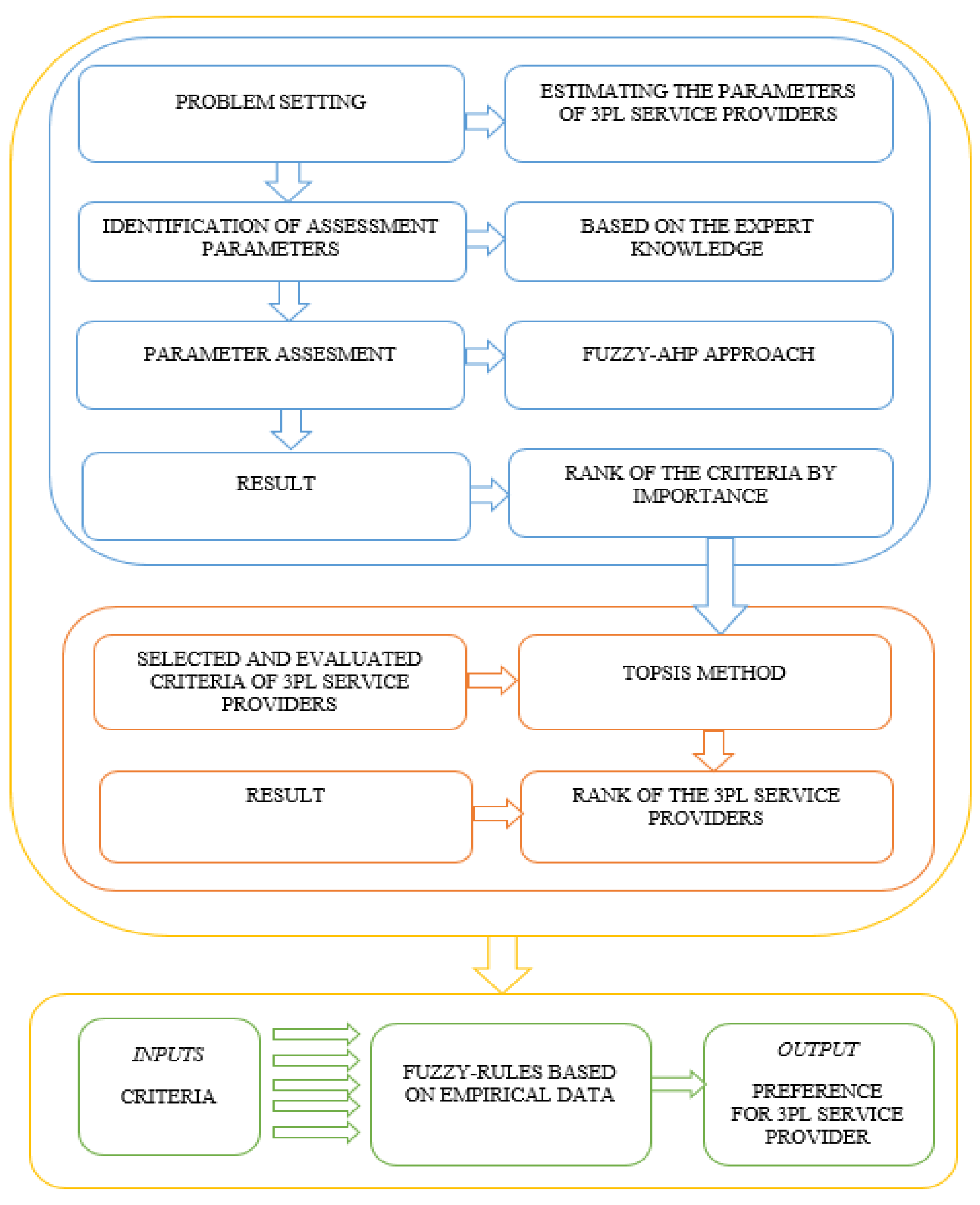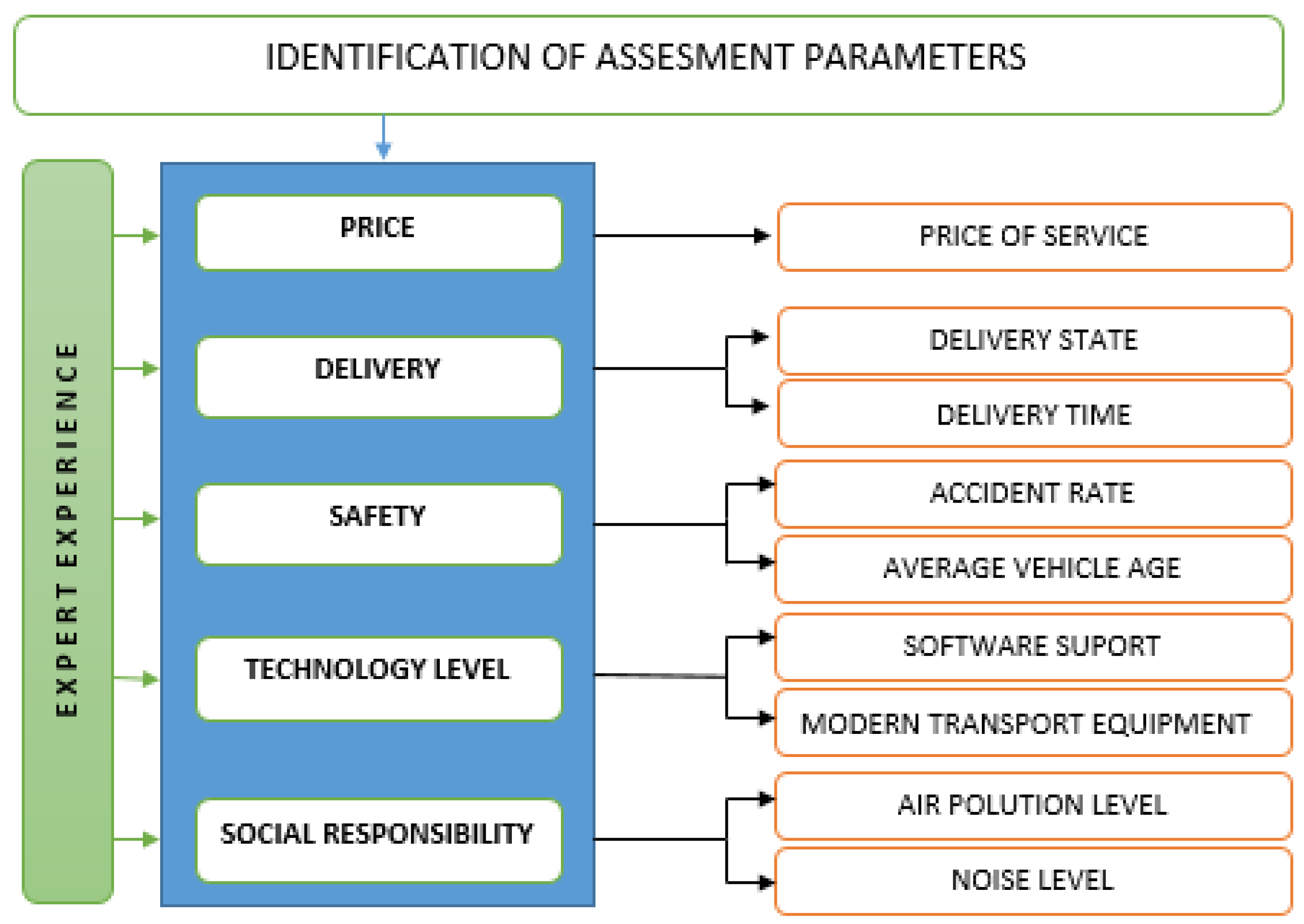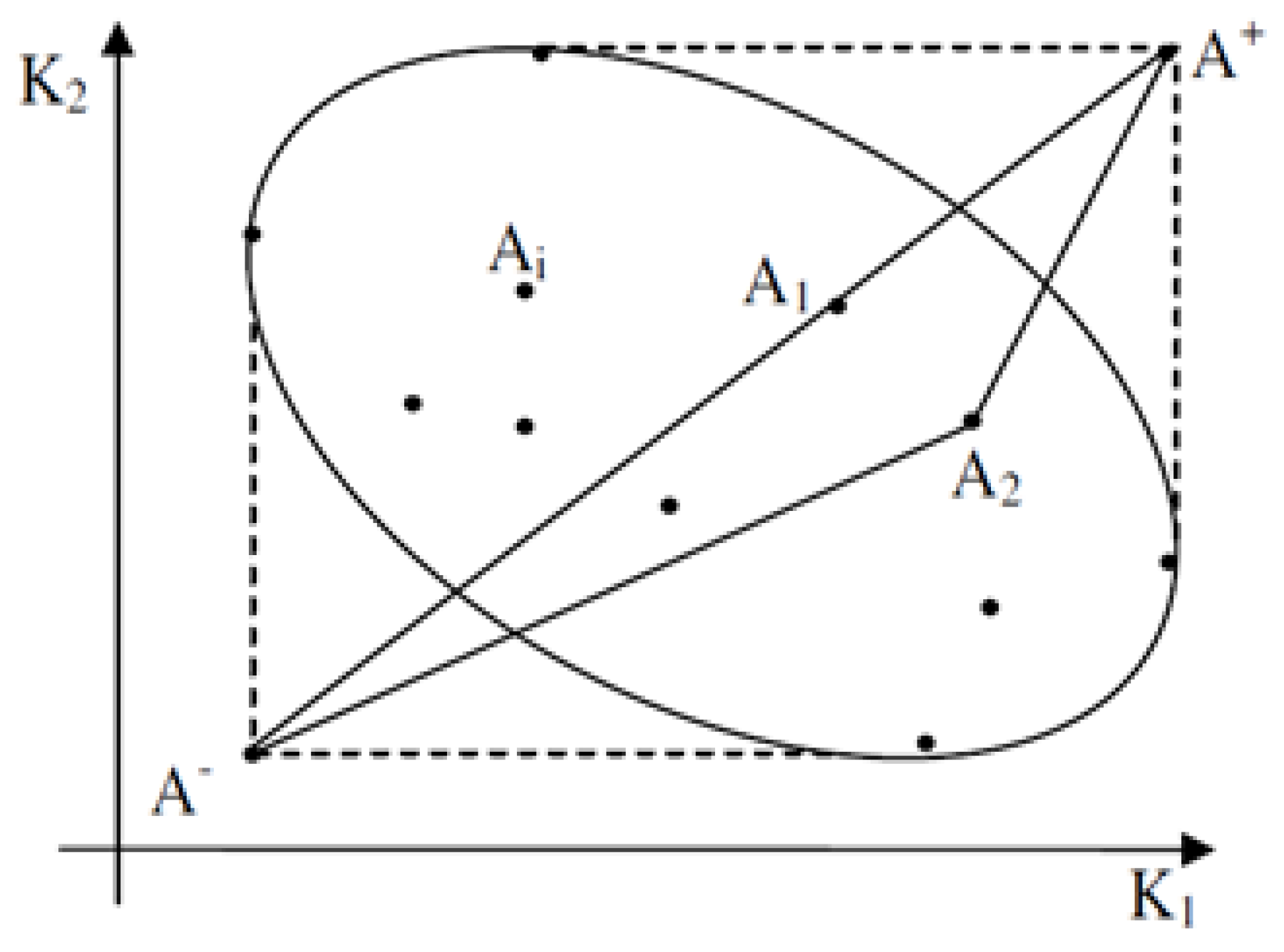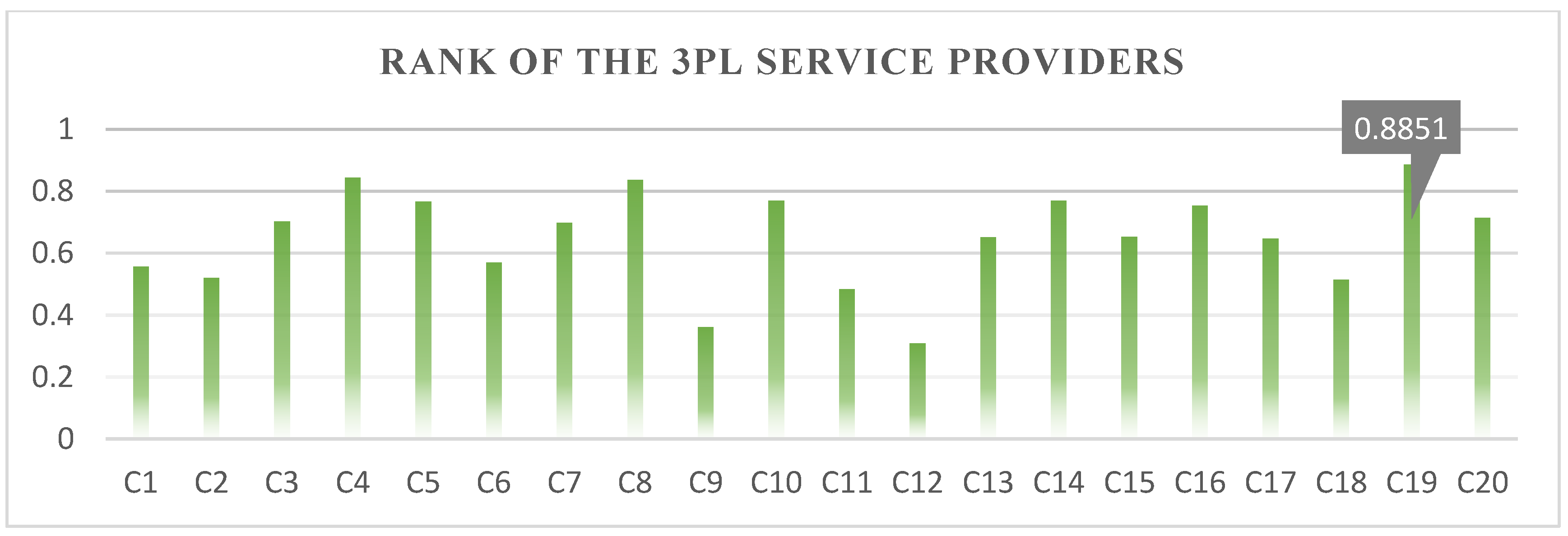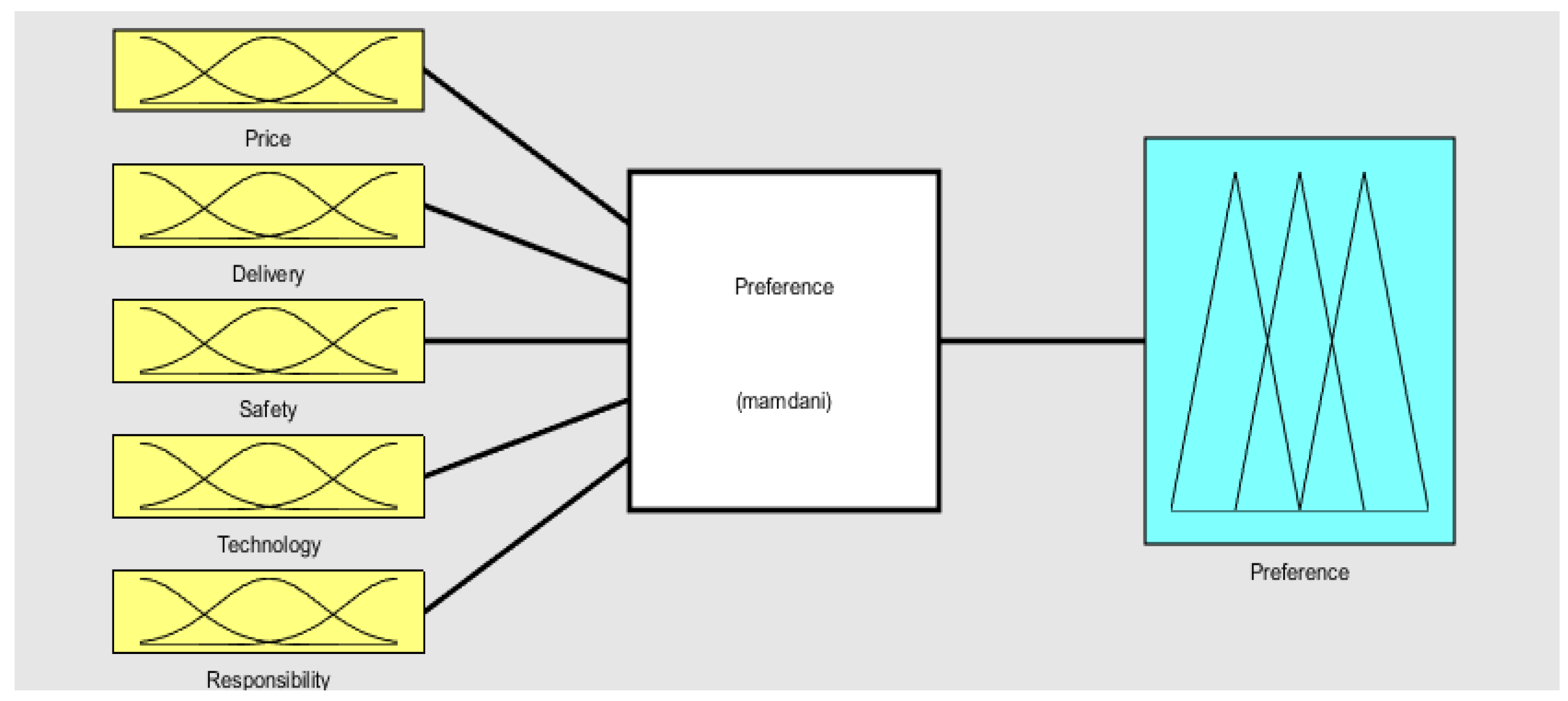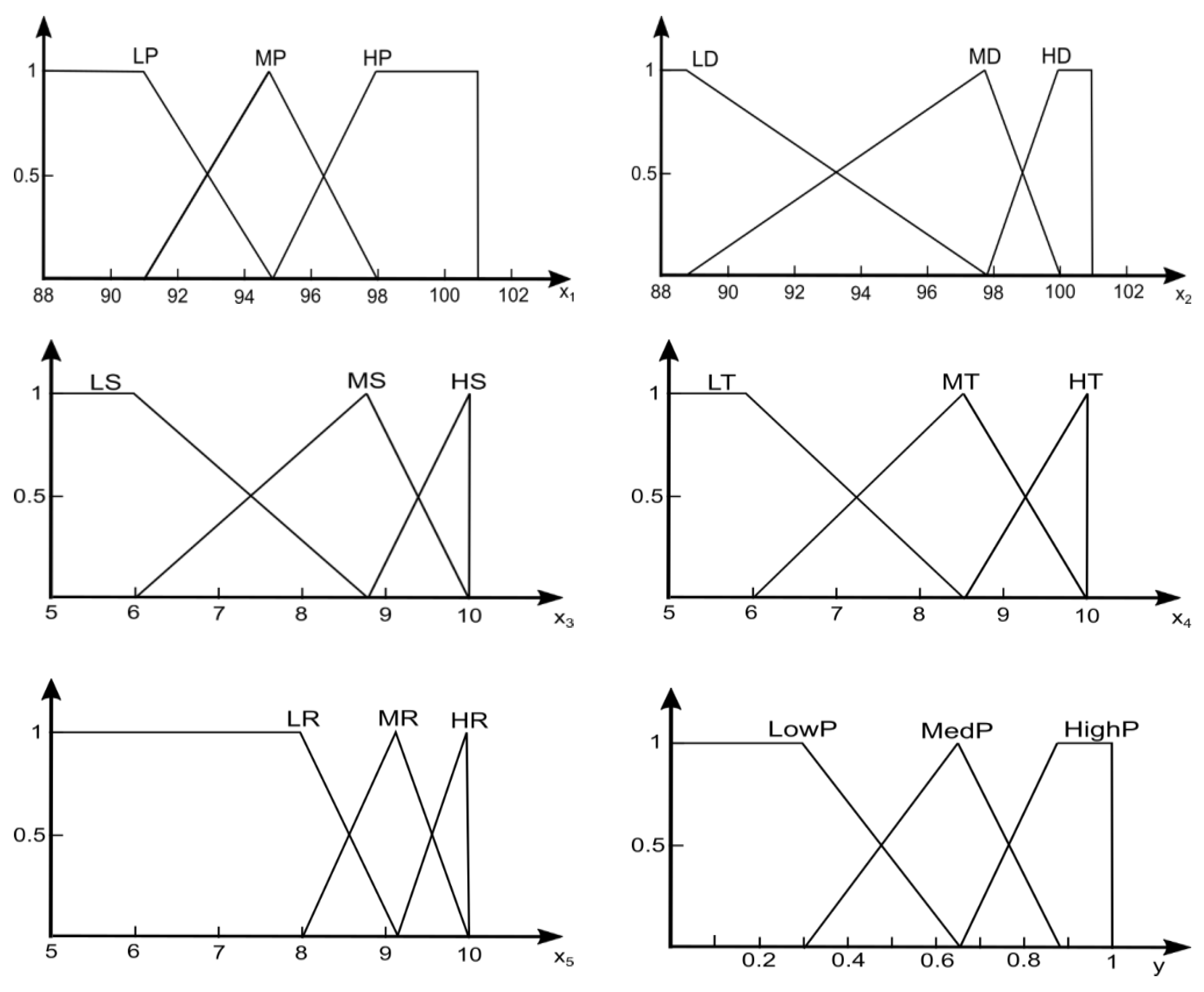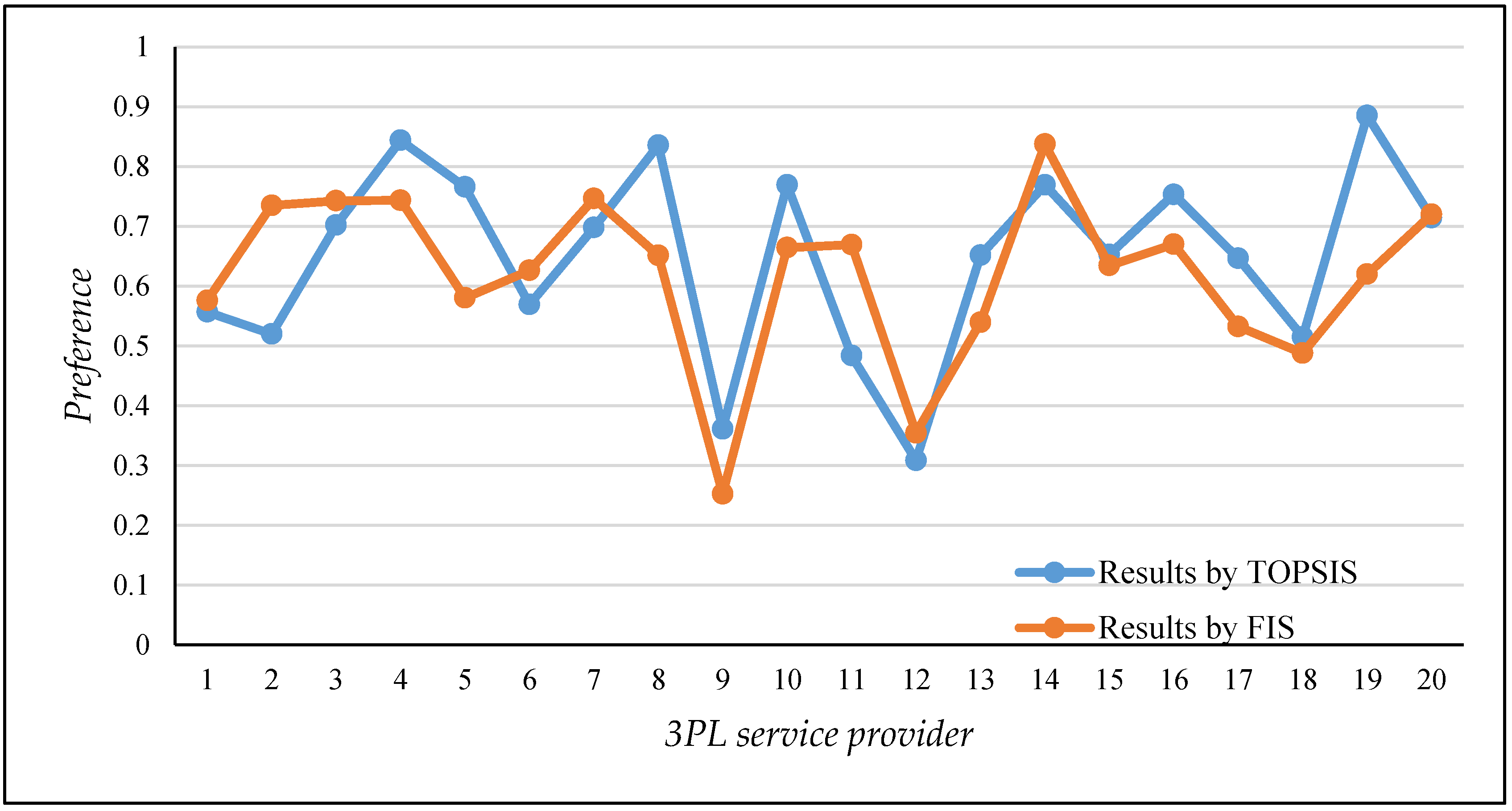1. Introduction
In recent years, the field of logistics and supply chain management has grown in both complexity and popularity. Nowadays, freight transport companies are faced with a large number of challenges and obstacles in the process of transporting goods from point A to point B. In today’s world of efficient production, companies choose a mode of transport that will bring the best value for business at the end of the process. To this end, a computer simulation method is often used [
1]. In order to stay competitive, companies not only strive to provide high quality services, but also to reduce costs [
2]. Many companies are trying to move away from own-account transportation, i.e., where a company provides its own transport services, to third-party transportation. In other words, they no longer perform many of their own logistics activities but use the principle of outsourcing. Outsourcing means that an organization hires an outside organization to provide goods or services that it traditionally provided by itself, because this third party is an “expert” at efficiently providing these goods or services, while the organization itself might not be so [
3].
This provides new opportunities for transport and logistics companies that are known as third-party logistics (3PL) service providers. By making the right decision about the logistics service provider, a company can greatly save cost and time and increase their competitive advantage in the market [
4]. On the other hand, a wrong decision might not only affect the decision-making company, but it might also have far-reaching consequences on the sustainability of society, particularly in terms of the common negative consequences of transport activities, such as air pollution, noise level, etc.
Due to the high level of competition in the market, it is challenging to choose an appropriate logistic provider, especially bearing in mind that there are various parameters through which they can be characterized. The number and complexity of the influencing factors brings us to the conclusion that this is a typical multi-criteria decision-making problem [
5]. Multi-criteria decision-making refers to the process of making decisions in the presence of multiple, usually conflicting, criteria. Some criteria can be presented numerically, and others can be described subjectively [
6]. There are many articles related to the evaluation and selection of third-party logistics service providers. It can be noticed that the Analytic Hierarchy Process (AHP) method has been proven to be a very useful and frequently used method for solving this task and other similar ones [
7]. One of the first studies where the AHP method was used to determine the priorities in selecting suppliers was conducted by Yahya and Kingsman [
8]. Chan et al. [
9] used the AHP method for the supplier selection problem. Fourteen criteria were taken into consideration. Further research based on the AHP was provided by Liu and Hai [
10]. They used this method to evaluate and select the suppliers. Hou and Su used the AHP method to solve a supplier selection problem in the mass-customization environment [
11]. The authors considered the internal and external factors in order to face the market needs within the global changing environment. Korpela and Touminen [
12] used the AHP to select the best 3PL warehousing in the processing industry. As the main criteria, they used reliability (compliance, accuracy, transportation, facilities/equipment, skills of personnel, and damage-free handling), flexibility (special requests, urgent deliveries, and capacity), and strategic compatibility (strategic alliance, strategic fit, and co-operation). So et al. [
13] evaluated the quality of service of 3PL in Korea by applying the AHP method. Gӧl and Çatay conducted a study on 3PL provider selection based on AHP in the Turkish automotive industry [
14]. They included the general company considerations, quality, client relationship capabilities, and labor relations.
When it comes to the combination of the Fuzzy and AHP methods, numerous studies have been conducted by various authors. A Fuzzy AHP method [
15,
16,
17] deals with the problems that use the concepts of fuzzy set theory and hierarchical structure analysis. Basically, the Fuzzy AHP method represented the elaboration of a standard AHP method into the fuzzy domain by using the fuzzy numbers for calculations, instead of the real numbers [
18]. This methodology was implemented in various fields. For example, it was applied for supplier selection in a washing machine company [
19]. Shaw et al. [
20] introduced a combination of Fuzzy AHP and Fuzzy Objective linear programing to select the best supplier for developing a low carbon supply chain. First, the Fuzzy AHP was used to determine the weights of the predetermined criteria, which were quality, cost, rejection percentage, late delivery percentage, greenhouse gas emissions, and demand. Second, the best supplier was determined by using Fuzzy objective linear programming. In studies [
21,
22,
23,
24], the AHP and Fuzzy approach were combined to solve the 3PL service provider evaluation problem. Cheng et al. used the Fuzzy AHP to calculate the relative importance among the individual dimensions and sub-criteria in the evaluation of fourth-party logistics (4PL) selection criteria [
25]. Arikan used the Fuzzy AHP method for the multiple-objective supplier selection problem [
26]. There were three main objectives: maximizing the service level, minimizing the total monetary cost, and maximizing the total quality.
The Technique for Order of Preference by Similarity to Ideal Solution (TOPSIS) method is one of the most frequently used methods for 3PL provider selection; however, it has wide application to solve complex problems in different areas. This multi-criteria analysis method is mostly used in combination with Fuzzy logic, the Analytic Network Process (ANP), and AHP. In the field of logistics service providers, there are numerous research studies that have used the TOPSIS and some other methods. For example, Jayant et al. [
27] combined the TOPSIS method with the AHP to select the reverse logistics service provider in a mobile phone industry. The objective of the study was to develop a decision support system to assist the top management of the company to select and evaluate different 3PRL service providers. In the same field, to evaluate 3PRL service providers, Govindan et al. introduced the implementation of Fuzzy AHP and the TOPSIS methodology [
28]. Chen and Yang [
29] used the limited Fuzzy AHP and Fuzzy TOPSIS to select suppliers. A similar methodology was applied by Singh et al. [
30] and by Yadav et al. for cold chain management in the Indian manufacturing industry [
31]. Laptate [
32] implemented a fuzzy modified TOPSIS method for the supplier selection problem in a supply chain. The modified TOPSIS method fuses the TOPSIS method and the linear programming problem. This method not only ranks the suppliers but also gives an idea about the order quantity from the selected supplier.
A group of criteria used to evaluate the performance of Logistics Service Providers is of particular importance in the decision-making process. In the research about fuzzy measures of supplier evaluation under lean concepts, Tsai [
33] used criteria pertaining to the service quality, on-time delivery, reliability of delivery, pre and post customer service, target market responsiveness, organization capability, price, and geographical coverage. Vaidyanathan [
34] developed a framework for evaluating third-party logistics based on the following criteria: price, innovation in services, pre and post customer service, and legal contracts. Control management, cost, employee relationships, and control over providers were the criteria used by Perçin [
35]. In research about the selection of a third-party logistics provider, Cooper et al. [
36] used the following criteria: on-time delivery, cost, order accuracy, consistency in invoices, response to a purchase order, orders received, flawless delivery, frequency of damage in transportation, inventory accuracy, inventory rotation, warehouse efficiency, returns, service level, transportation risk, and warehouse risk. Rattanawiboonsom emphasized the transportation risk and warehouse risk as two main criteria for selecting a third-party logistics provider [
37]. Guneri et al. used an integrated Fuzzy linear programming approach for a supplier selection problem [
38]. Criteria such as quality, reputation, the closeness of the relationship with suppliers, and reliability were taken into consideration.
Dikson used 23 criteria in research related to the evaluation of suppliers. In his study [
39], quality, delivery, historical performance, and warranty were taken as very important factors. Great importance was assigned to the management and organization, operational costs, production plants, technical abilities, net price, financial position, procedural compliance, communication system, reputation and position in the industry, and willingness to do business. Middle importance was assigned to criteria such as repair services, attitude, impression, packaging, relations with working staff, geographical location, previous business, and improvement. Reciprocal agreements were considered to have the lowest importance.
Ellram performed a study about supplier selection in the strategic partnerships [
40]. Criteria such as financial aspects, technological issues, organizational structure with strategic issues, and other factors were used. Stević emphasized that the criteria established by Ellram aim to encourage a long-term partnership between the company and suppliers as well as to generate the possibility of securing the source of supply for a longer period of time [
41]. He also stated that the financial parameters as well as quality and delivery were the criteria used by various authors to select a supplier [
42,
43,
44,
45,
46,
47,
48,
49,
50,
51,
52,
53,
54].
Aktas and Ulengin conducted a study on outsourcing logistics activities in Turkey [
55]. In selecting a transportation carrier, they considered different criteria, but the general tendency was either to select the carrier with a good reputation and/or the one that is easy to collaborate with. The criteria that they took into consideration were the flexibility in customer inquiry, response in the delivery cycle, ease of collaboration, mutual trust, and information sharing.
Further research was related to a framework for analyzing factors that influence the market share of third-party logistics in the high-tech industry [
56]. The following criteria used for that purpose were cost savings, variety of services, company size, and value-added services. The obtained results indicate that the strongest determinant of industrial demand choices is the service performance of the third-party logistics, followed by the service cost and added value.
Vijavargiya and Dey considered criteria such as cost (inland transportation and ocean/air freight), delivery (schedule flexibility), and value-added services (clearing and forwarding and IT-Track and Trace) [
57]. Yang et al. conducted research based on the logistics service provider selection for air cargo by considering criteria such as performance, features, reliability, conformance service ability, and perceived quality [
58]. Kabir selected quality, cost, and delivery time in order to solve the problem of 3PL provider selection [
59].
Weber et al. [
60] established criteria with an aim to encourage the creation of a long-term partnership between the company and suppliers as well as to create the possibility of providing sources of supply for a longer period of time. They divided the criteria into those of great importance (net price, delivery, and quality) and those of little importance (production plants, geographical location, technical abilities, financial position, management and organization, reputation and position in the industry, and historical performance). Verma and Pullman conducted a study to analyze the supplier selection process [
61], in which customers select suppliers based on the relative importance of different attributes such as price, quality, flexibility, and delivery performance. Their research indicated that managers pay the most attention to quality, considering it the most important parameter of the supplier, followed by the delivery and price.
By analyzing the literature in the field of 3PL selection, it may be concluded that different evaluation criteria can be used; however, the intention of the authors of this paper was to design a model with the main features and the advantage of being easy to implement in practice. To achieve this, the numerous evaluation criteria should be reduced to a lower number. Accordingly, these criteria should be more general to cover a broader field of interest for 3PL selection. In this paper, this is performed by using the five criteria described in the next section. This number of criteria has been proven to be relevant [
62], and the concrete chosen criteria are the most frequently applied in the literature [
63].
The methodology proposed in this paper consists of three separate parts. After the implementation of a well-known Fuzzy AHP method and TOPSIS, a fuzzy inference system (FIS) that gives a preference for selection of a 3PL provider is proposed in the third part. A proposal of decision-making tool of this kind, which is based on empirical data, may be seen as the main contribution of the current paper. To generate the fuzzy rule database, which is the essence of FIS functioning, we use empirical data from 20 3PL providers as input values, and we use the preferences calculated by TOPSIS method as output values. The novelty of the study is its ranking of the 3PL service providers in the economic, safety, environmental, technological, and social dimensions, which is of crucial importance for the sustainability of the logistics industry and global society.
This paper is organized as follows:
Section 1 gives a general overview of the considered problem. In
Section 2, a Fuzzy AHP approach is implemented to define the evaluation criteria for 3PL service provider selection and to estimate the influential relationship between them.
Section 3 deals with the TOPSIS method for 3PL service provider selection which gives the basis for testing, as well as for the design of the fuzzy rule database of the FIS. The main contribution of this paper is found in
Section 4, where a decision-making tool for 3PL service provider selection is modeled. Here, a fuzzy inference model is designed based on the empirical data collected by the authors. The proposed model is particularly suitable for implementation when there is no concrete numerical input data, but rather, the data are given descriptively, through linguistic statements. Finally, there are some concluding remarks.
4. The TOPSIS Methodology for 3PL Selection
The Technique for Order of Preference by Similarity to Ideal Solution (TOPSIS) is a multi-criteria decision analysis tool, which was originally developed by Hwang and Yoon in 1981 and Hwang et al. in 1993 [
72,
73]. Alternatives to the TOPSIS method were evaluated based on their distance in relation to the ideal and anti-ideal solutions. The alternative was considered the best if the distance was minimal in relation to the ideal solution and if greatest distance from the anti-ideal solution was the greatest.
Figure 3 shows the spatial distribution of alternatives defined by two criteria of the max type.
and
, respectively, mark the ideal and anti-ideal solutions.
The symbols A
1, A
2, …, A
m are alternatives from which the best should be selected, while the labels K
1, K
2, …, K
n are the criteria which impact on the selection procedure. X
ij represents the value of the
i-th alternative according to the
j-th criterion. The marks max/min indicate the types of criteria; that is, certain criteria should be maximized, while others should be minimized. W
1 … W
n denote the weights of the criteria or their significance. The TOPSIS method is based on the following steps [
74]. The first step is data normalization, i.e., the reduction of input data to an interval of values 0 to 1. The normalization is done based on the following equation:
where
R is a normalized matrix and
is normalized data.
The next step is the multiplication of normalized data with the normalized weights of the criteria based on the following equation:
whereby
is obtained in the following way:
Based on the obtained values from the previous step, the following step is the formulation of the above-mentioned ideal and anti-ideal solutions (
and
).
represents the ideal solution, which has all the best characteristics of all the criteria, and
is an anti-ideal solution that has all the worst characteristics of all criteria. These solutions are obtained by Equations (11) and (12):
represents a subset of the K set, which consists of criteria of the max type, and represents a subset of the K set, which consists of criteria of the min type.
In the next step, the Euclidean distance of each alternative from the ideal and anti-ideal solution is determined:
where
represents the distance of the
i-th alternative from an ideal solution, and
represents the distance of the
i-th alternative from an anti-ideal solution.
After this step, the relative closeness of the alternative to the ideal solution is obtained based on the formula:
4.1. Application of the TOPSIS Methodology for the Selection of a 3PL Service Provider
The TOPSIS methodology is a very reliable tool that can be used to determine the preferences of 3PL service providers. In this paper, this method was used to select an appropriate 3PL service provider. A total of 20 3PL service providers from the territories of the Czech Republic and Poland were compared and evaluated. The best possible solution was the best 3PL preference according to the price, delivery, safety, level of technology, and social responsibility. By comparing the 3PL service provider, as a unit for the price, the euro cent per km was determined. Different logistics providers perform transport services at different prices ranging from 91 to 98 Euro-cents. When it comes to delivery, we took into account the percentage of on-time deliveries. This percentage varied between 88.89 and 99.98%. The remaining three criteria concerning the safety, lev of technology, and social responsibility for 3PL providers were taken into consideration on a scale from 5 to 10, where 10 indicated the maximum grade. The empirical data on 3PL service providers are shown in
Table 5.
The next step, followed by the methodology, was the normalization of input data. It was performed by finding the sum by the columns of all the criteria separately and then dividing each element by the sum in the given column. The results of this process are shown in
Table 6.
The results of the previously implemented Fuzzy AHP method, where the importance levels of criteria were determined, were used in the TOPSIS method. Each value obtained by normalization was multiplied with a given weight, and
Table 7 shows the weighted decision-making matrix. The final results obtained by the TOPSIS method are shown in
Table 8 and
Figure 4.
4.2. Sensitivity Analysis of TOPSIS Methodology
Since the weights of the criteria were determined according to the expert opinion, it was useful to perform a sensitivity analysis of the implemented TOPSIS methodology. This means that we examined how the change in the weight of one criterion affected the final ranking of the alternatives. However, since the sum of all criteria was equal to 1, if the weight of the
p-th criteria changed by Δ
p, then the weight of the other criteria changed by Δ
j, where [
75]
The results of testing the criteria “price” are given in
Table 9. The first column gives the level of weight change in price. Then, in the second column, there are new weight values for all five criteria, and finally, the best-ranked 3PL service provider is presented.
Table 10 presents the results obtained for the remaining criteria: delivery, safety, technology level and social responsibility.
The results of the sensitivity analysis reveal that the most stable criteria in the proposed model are price, delivery, and safety. On the other hand, relatively smaller changes in weight for the technology level and social responsibility led to changes in the ranking of alternatives.
5. The Proposal of a Fuzzy Model for 3PL Service Provider Selection Based on Empirical Data
In this chapter, we describe the development of a fuzzy inference model (FIS) for selecting a third-party logistics provider (
Figure 5).
The proposed FIS was designed by using empirical data which were obtained in the previous part of this paper. The considered criteria, price, delivery, safety, technology level, and social responsibility, were taken as input variables. The output variable was a preference for the 3PL provider. The FIS was based on Wang–Mendel‘s method for determining fuzzy rules. This method combines both linguistic and numerical information into a common framework. The fuzzy rules are essential for designing an FIS and thus for forming a decision-making tool for 3PL selection. There is a possibility to implement the interval type-2 fuzzy sets for the same purpose [
76,
77]; however, in this case, the type 1 fuzzy system achieved satisfactory results.
5.1. Input and Output Variables
The first input variable was the price, and we described this variable by three fuzzy sets: low price (LP), medium price (MP), and high price (HP). As for the price, we set the upper and lower limits for all other criteria as well as the average values. This was done by analyzing the empirical data collected by the authors of this paper. We supposed, according to our empirical data, that the price was low if the 3PL service provider provided a transport service at between 83.32 and 94.8 Euro-cents per km. The price was classified as medium (MP) if the 3PL service provider requested costs for their transport service of between 91 and 98 Euro-cents per km. The price was considered high (HP) if the transport cost was between 94.8 and 106 Euro-cents per km. In a similar way, all the other variables were defined based on the collected data. The descriptive statistics of the sample are shown in
Table 11. Consequently, all used variables were designed as shown in
Figure 6.
5.2. Determining the Fuzzy Rules
Next, the authors used a well-known method, which combines both numerical data and expert opinion, for the design of fuzzy rules. We implemented the Wang–Mendel method, which is characterized by five steps [
78]:
The first step divides the input and output spaces into fuzzy regions. The second step generates fuzzy rules from given data pairs. The third step assigns a degree to each rule. Since there are usually lots of data pairs, and each data pair generates one rule, it is probable that there will be some rules, so-called conflicting rules, that have the same “if” part but a different “then” part. Based on the calculated degree of each rule, which we obtained by implementing the appropriate programming code, we selected the non-conflict fuzzy rules that form the final rule database. The fourth step creates a combined fuzzy rule database using both the linguistic rules of human experts and the generated rules from data. Finally, the last step determines a mapping based on the combined fuzzy rule base using a de-fuzzifying procedure.
We formulated a set of input–output data pairs:
where
X1,
X2,
X3,
X4, and
X5 (
X1—price,
X2—delivery,
X3—safety,
X4—level of technology,
X5—social responsibility) are taken as inputs in the FIS.
Y represents an output of the system (a preference for 3PL service provider). The numbers in brackets represent the exact 3PL provider. This is a five-input, one-output case.
The task is to generate a set of fuzzy rules from the collected input–output data pairs and use these fuzzy rules to determine a mapping (X1, X2, X3, X4, X5)→Y.
Step 1. Divide the input and output spaces into fuzzy regions.
According to the empirical data, we set up the domain intervals of
X1,
X2,
X3,
X4,
X5 and
Y as [
−
], [
−
], [
−
], [
−
], [
−
], and [
−
], where the “domain interval” of a variable means that most probably the values of this variable will be in the set interval. Each domain interval was divided into 2
N + 1 regions. In this case, each variable is defined by three regions. We denoted them by L (low), M (medium), and H (high). A fuzzy membership function was assigned to each region, which was done based on the data shown in
Table 11.
Figure 6 represents the domain intervals from
x1 to
x5 respectively, divided into three regions (fuzzy sets), and the domain interval of an output variable
y was divided into three regions as well. The shape of each membership function was triangular. Even though the shapes of membership functions may be different, this was not expected to change the results significantly.
Step 2. Generate Fuzzy Rules from Given Data Pairs
In this step, we determined the degrees of
X1(i),
X2(i),
X3(i),
X4(i),
X5(i) and
Y(i) in different regions and chose the regions of the maximum degree. For example, in the case of the 10th 3PL provider,
X1(10) = 97 cents. This value has a degree equal to 0.3125 in MP and a degree of 0.6875 in HP. The remaining region was not considered, since its degree is equal to zero. The values of the membership degrees for all variables in the case of 10th 3PL provider are presented in
Table 12.
Based on the obtained values of degrees, where the maximum degrees are presented in bold, the following fuzzy rule was formed:
IF X1 is High Price (HP) and X2 is High Delivery (HD) and X3 is Medium Safety (MD) and X4 is Medium Technology (MT) and X5 is Medium Responsibility (MR), THEN Y is High Preference (HighP).
This procedure was performed for all remaining 3PL providers from the sample; therefore, we obtained 20 fuzzy rules.
Step 3. Elimination of the same or conflict rules
The purpose of this step was to form a fuzzy rule base containing just rules from empirical data that were not in conflict or the same. The conflicting rules had the same IF part, but a different THEN part. To resolve this, we had to calculate the degree of each rule,
D(i), according to Equation (18) for the case when a rule is defined as follows: “IF
X1 is A and
X2 is B and
X3 is C and
X4 is D and
X5 is E, THEN
Y is F”.
D(i) is a degree of the
i-th rule,
is a value of the membership function of region A when the input value is
x1, etc. In a conflict group, only the rule that has the maximum degree may be accepted. In this case, we obtained 16 rules from the empirical data in the final fuzzy rule base, which are shown in
Table 13.
Step 4. Design of the combined fuzzy rule base
The final fuzzy rule base should consist of 243 fuzzy rules. Besides the previously-mentioned 16 rules that were obtained based on empirical data, we generated the remaining rules based on expert opinion. In this process, the following logic was implemented: if the price of service was higher, then the preference for selection of observed the 3PL provider was lower; if the delivery value was higher, then the preference was higher; if the safety value was higher, then the preference was higher; if the technology level was higher, then the preference was higher; and if the social responsibility was higher, then the preference was higher.
Step 5. Determine a mapping based on the combined fuzzy rule base.
In this step, the proposed FIS was tested, and the obtained results are given in
Table 14. To compare the results of FIS and preferences obtained by the TOPSIS, the Cumulative Error (
CE) was calculated according to Equation (22) [
79]:
where
CE represents the Cumulative Error in the description of the data,
is the preference calculated by the TOPSIS method, and
is the result of the FIS.
The value
CE may be used to compare the proposed FIS with some other FIS that would be defined based on some different principles. A smaller value of
CE indicates a better matching between the empirical data and FIS. A comparison of the results from this research obtained by TOPSIS and FIS is shown in
Figure 7. By analyzing
Figure 7, it is possible to conclude that the proposed FIS gave similar results to TOPSIS; however, there is a possibility for improvement of this FIS structure. This statement is based on the fact that, in this empirical case, the best ranking 3PL service provider was not the same in two proposed decision-making techniques. The explanation for this discrepancy may be found in the third column of
Table 14, where the highest deviation occurred in the case of 3PL-19. Optimization of FIS structure can be done in various ways, and in this paper, the effects of changes in the shapes of membership functions were tested.
5.3. Sensitivity Analysis of the Proposed Fuzzy Model Based on Changes in the Shapes of Membership Functions
In the case of triangular membership functions, the value of
CE was equal to 1.9901. This value of
CE was further compared with the other FIS structures where the shapes of the membership functions were changed. Additionally, the testing of different FIS structures may be seen as a starting point in the optimization of the FIS structure in the pursuance of achieving the same conclusion about the best 3PL provider as in the case of TOPSIS. The results of the testing can be seen in
Table 15.
The conclusion of the testing procedure related to changing the shape of membership functions was that there is no differences in the best 3PL service provider. This means that some other optimization techniques should be implemented, which may be a future research direction. When it comes to the empirical implementation of the proposed models, in the case of crisp input values, the TOPSIS should be used—while, in the case of imprecise input data, the proposed FIS structure is a convenient choice.
6. Conclusions
By selecting the most suitable 3PL service provider, a company can greatly save on costs, improve the quality of the business, as well as maintain existing and gain new customers. A decision about the selection of a 3PL provider may be affected by the methodology used as a decision-making tool and the criteria and sub-criteria chosen for evaluation.
In this paper, we propose the use of the TOPSIS and FIS structure as a decision-making tool that can be implemented by companies which need the services offered by 3PL providers as an outsourcing activity. These techniques perform an evaluation on a set of available 3PL providers in the market and then give the result as a preference for choosing each of them.
The FIS is designed based on the empirical data from 20 3PL providers. The first part of the research prepared data for the FIS structure. This means that the Fuzzy AHP approach was implemented to define the evaluation criteria for 3PL service provider selection and the influential relationships between the criteria. Furthermore, the TOPSIS method was used to obtain the preferences for the 3PL service provider selection to give a basis for testing the proposed FIS.
While performing the evaluation of criteria by the Fuzzy AHP method, the following results were obtained: the highest importance was attributed to the price (0.5148), followed by the delivery criterion and safety, using the weights 0.211 and 0.1951, respectively. The level of technology had a weight of 0.047, while the social responsibility participated with a weight of 0.031. The considered criteria and their importance weights were further used in the TOPSIS method, as well as in the final step, to design the FIS. The results of the TOPSIS method, together with the collected data on input variables, were utilized to form a fuzzy rule database by the Wang–Mendel method.
The proposed FIS structure may be implemented in practice, particularly in cases where there are no concrete numerical input data, but rather, they are, partially or completely, given descriptively through linguistic statements. In the case of crisp input values, the implementation of TOPSIS would be sufficient. A direction for future research may be to adjust the proposed FIS further, by optimizing it through minimizing the cumulative error in describing the empirical data and by harmonizing the final decision with TOPSIS. Additionally, testing the proposed methodology on different samples would be of particular interest.
